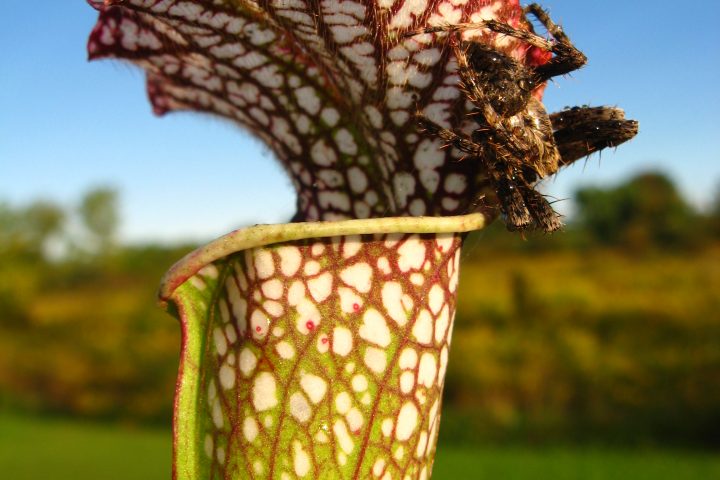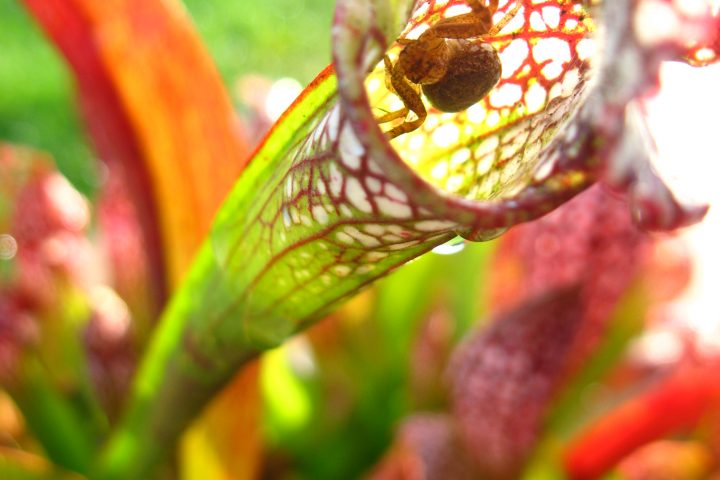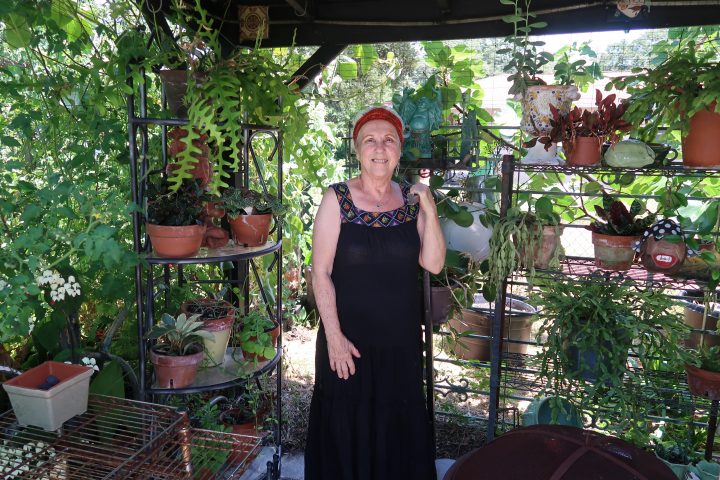Inspired by the beverage garden at Florida Botanical Gardens in Largo, I have been researching and planting a drinkable landscape. Shrubs which produce berries, perennial herbs and fruiting trees are some of the additions you can make to your garden to spritz up your drinks. Our Florida gardens can refresh us far beyond lemon water, orange juice or grapefruit juice. Start thinking garden-to-glass!
Tea shrub (Camellia sinensis) is one of the first plants I think of when I imagine a beverage garden. It can be grown where ornamental camellias are grown and does best in filtered light. Tea shrubs cannot handle flooding. Nursery tea plants are usually sold in 1- to 3-gallon pots. They can grow into a small tree or large shrub. When planting the tea shrub in a sandy soil, dig a hole three to four times the diameter and 3 times as deep as the pot it came in. It is not recommended or necessary to mix fertilizer or topsoil to this area. The excavated area, loosens the soil, making it easy for the roots to grow.
Paul Zmoda, a Riverview horticulturist who enjoys doing fruit research on his property says, “In the early spring you may begin leaf harvest. Using your fingernails, nip off the top-most two leaves. If the third leaf is tender enough, clip this off also.”
I met Paul at the Tampa Rare Fruit Council – a great place to learn about growing exotic fruits that can be turned into a snack or drink. Search to see if you have a Rare Fruit Council chapter in your area.
To prepare your tea leaves as black tea, wither them in a warm shady spot for up to a day. Knead the leaves as if they were bread dough. “After the rolling procedure, the tea is formed into a wet, sticky ball and allowed to rest while fermentation occurs for up to 6 hours. The tea is then broken up, placed onto a pan, and put into a 170-200-degree oven to dry” Zmoda explains. As they dry in the oven, stir them often.
To process green tea, place the plucked leaves directly in a double boiler for 7 to 9 minutes and then knead like black tea and dry in the oven. Tea can be made by steeping your cured leaves for 3 to 5 minutes. “Longer steeping will result in the bitter, undesirable tannins leaching out,” Zmoda warns. If you have your FG archives Paul wrote an entire article on growing tea in the December/January 2006 issue.
A year ago, I was lucky enough to experience the cloud mountains of Peru. Growing on the steep slopes of the mountains were bananas and coffee plants. Then back home, in sunny Florida I visited the Florida Botanical Gardens and found similar plants growing. The adaptability of plants is astonishing.
Coffea arabica is usually grow in shade but will produce more fruit in full sun through its native habitat. The optimal temperature range is from 60 to 75°F. Growing coffee in shade or in pots is ideal for Florida’s climate. Coffee plants may be damaged by freezing temperatures. Plants are usually pruned to heights that allow for ease of harvest. A 6-foot tree can produce between 2 and 10 pounds of dried beans a year.
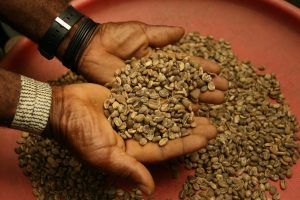
To harvest allow the berries to turn red and remove the seeds. Place the seeds in water for three days for fermentation. Remove the beans from the water and dry in the sun for approximately two days. During this time the color will change from reddish brown to light brown. Fairchild Tropical Botanic Gardens recommends roasting the beans in a 250°F oven for seven minutes. Then increase the oven to 450°F and roast for an additional ten minutes until the beans crackle. Remove the hulls by winnowing and then grind the beans in a coffee grinder.
For those with limited space herbs are a great way to enhance homemade beverages. Mexican marigold (Tagetes lucida) has a tarragon-like flavor, with a hint of anise. Fresh or dried leaves can be used as a tarragon substitute. A tablespoon of leaves or flowers can be added to a cup of water for tea. The plant is a perennial and will reach a height of 18 to 30 inches. It is drought tolerant but will look fuller and produce more flowers in moist conditions. I bought 8 1-gallon pots that were about 20 inches tall for around $7 each at the USF plant sale. It has been a year or so and the plants are still doing well, despite the multiple freezes.
Mounjean tea (Nashia inaguensis) is an herb I purchased from D&D growers a few years back at another USF plant sale which has grown into a small bush. Also known as pineapple verbena it is a native to the east Caribbean islands and will not forgive you if you let it go dry. The leaves smell of a mix between citrus, vanilla and pineapple and makes a mild herbal tea. This herb is commonly sold as a bonsai due to its miniature leaves and berries.
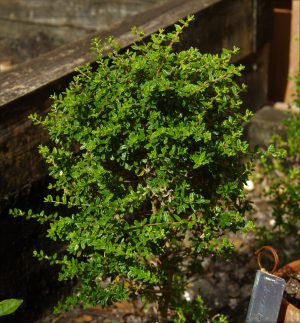
I purchased a small yerbe mate (Ilex paraguariensis) tree awhile back which grew slowly at the beginning and is now full of new growth. It has the potential to grow into a towering tree, but most are pruned to 12 feet to make harvesting easier. It can be made into a tea which boosts energy and mental stimulation. Many indigenous South American called it the “drink of the gods,” while European settlers called it the “green gold of the Indios.” To harvest, blanch the leaves in boiling water for a minute and then dry on racks to produce a brown leaf tea.
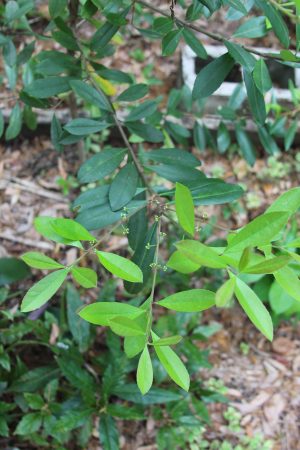
True roselle (Hibiscus sabdariffa) or Jamaican hibiscus makes for a great tea, jam or syrup. It is sour, packed with flavor and would also taste great in a salad. It is usually propagated by seed or cuttings. I have had zero luck with this plant. I have also given it zero care, by planting it in the middle of the yard, far away from my vegetables or a water spigot. I’m sure I forgot to water it a handful of times, which led to its demise. When it is thriving, it can reach a towering seven to nine feet and produce loads of calyxes. After the flower has bloomed pick the ripe calyx one to two days later. Separate the calyx from the seed pod, trying to keep the calyx whole. Dry the calyxes for year-round tea.
A ton of herbs and fruits can be used to flavor the aforementioned teas or store-bought teas. Herbs can be planted along walkways or between larger plants. Lavender, mints, pineapple sage, anise hyssop, add glamor to many drinks when a few leaves are added. Passion fruit or citrus are a great addition to teas or cocktails as well. Fruiting shrubs in the beverage garden would also benefit your culinary adventures. Cucumber mint lemonade, watermelon punch, blackberry lemon fizz, hibiscus strawberry are a few ideas to get you jump started.
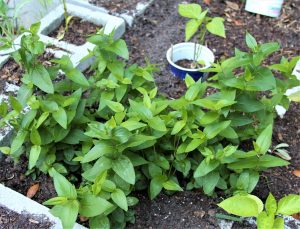

Homemade Herb Sweetener
- 1 large handful of herb leaves of your choosing (Try anise hyssop, mint, bee balm, basil, rosemary, bay leaves OR lavender)
- Equal parts water and sugar
Directions
Bring to a boil all ingredients. Remove from heat and steep for half an hour. Strain and refrigerate. Add syrup to lemonades, teas, or cocktails.
Anise Strawberry Cocktail
- 1/2 oz anise hyssop sweetener
- 3 oz vermouth
- 1 oz vodka
- 2 strawberries
Directions
Place ice and liquid ingredients into a cocktail shaker. With a fine mesh strainer juice the strawberries into the shaker. Shake until cold and strain into a glass.
Strawberry-Basil Martinis
- 5 strawberries, plus 1 for garnish
- 1-ounce basil sweetener
- Ice
- 4 ounces gin or vodka
- 1-ounce fresh lime juice
Directions
Muddle strawberries and basil sweetener. Add ice, gin or vodka and lime juice. Shake and strain. Garnish with a strawberry on the rim and float a basil leaf.
Rosemary & Lemon Bourbon Sours
- 1 1/2 ounces bourbon
- 1-ounce fresh lemon juice
- 3/4-ounce rosemary sweetener
- Ice Cubes
Directions
Shake or stir and pour over ice. Use a sprig of rosemary as the stirring stick.

To learn more about homesteading and growing drinks!, check out my newest book: 99½ Homesteading Poems

